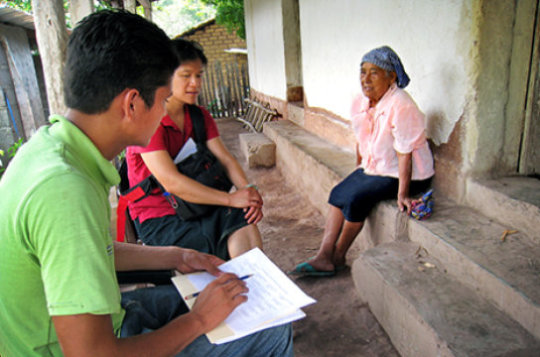

Convincing a large group of people to change its behavior is no popularity contest, a new study shows.
In a novel experiment, researchers found that certain public health interventions work best when key “influencers” in a face-to-face social network are exposed to the program. What’s surprising, they say, is that those key influencers are not the most socially connected people in the network.
Furthermore, those individuals can be identified through a survey method informed by network structure rather than costly and time-consuming social network mapping. The result is a cascade of behavior changes that boosts the efficiency and reach of certain programs.
“People are connected, and so their health is connected. Why not exploit this basic fact so as to improve health care delivery?” said Nicholas A. Christakis, director of the Yale Institute for Network Science and corresponding author of the study, published online May 5 in the journal The Lancet.
“We humans construct elaborate social networks in which we live out our lives. If scientists can understand the structure and function of these social networks, we can take advantage of this understanding to turbo-charge behavioral interventions so that whole groups of people change their behavior for the better, and not just isolated individuals,” said Christakis, who is a professor of sociology, ecology & evolutionary biology, biomedical engineering, and medicine at Yale.
Christakis and his colleagues tracked the effectiveness of a water purification program and a multivitamin program in the Lempira region of Honduras. Recruiting 5,773 residents from 32 villages to participate, the researchers used three methods to select initial targets for the programs: randomly selected villagers, villagers with the most social ties, and one nominated friend for each of a set of random villagers. Targets were given vouchers to distribute to their social contacts, who could redeem them for the health products and for additional vouchers.
The goal was to see which targeting method resulted in the greatest uptake of the health interventions. The researchers found that targeting nominated friends — key influencers — of random villagers sparked the highest level of adoption for the nutritional program. That method increased adoption of the program by 12.2%, compared with random distribution. Meanwhile, targeting the most highly connected people produced no increase in adoption of either public health program.
“Over the past decade, we’ve learned a great deal about how network structure affects the diffusion of information and behaviors,” said David A. Kim, an M.D./Ph.D. student at Harvard and the study’s first author. “The question now is whether we can meaningfully use this knowledge to enhance the spread of useful information and practices in the real world.”
Kim said the research has positive implications for public health programs and behavior-change research. “The best-performing method, in which we target the friends of randomly selected individuals, is simple and inexpensive to implement, and may be more efficient and more equitable than targeting the best-connected people in the network,” he explained.
In a commentary that accompanied The Lancet study, University of Wisconsin-Madison sociologist Felix Elwert said the research “marks real progress” in understanding the dynamics of face-to-face social networks, as opposed to online social networks. “Many public health interventions cannot be implemented via LinkedIn or Facebook,” Elwert noted.
As for why the most socially connected members of a network aren’t the key influencers, Christakis said it might be a result of popular individuals being overly clustered amongst themselves. “Because highly connected people tend to be friends with one another, targeting only the best-connected people risks creating an ‘echo chamber’ of influence that fails to reach other parts of the network,” Christakis said.
Story Source:
The above story is based on materials provided by Yale University. The original article was written by Jim Shelton. Note: Materials may be edited for content and length.
Journal Reference:
- David A Kim, Alison R Hwong, Derek Stafford, D Alex Hughes, A James O’Malley, James H Fowler, Nicholas A Christakis. Social network targeting to maximise population behaviour change: a cluster randomised controlled trial. The Lancet, 2015; DOI: 10.1016/S0140-6736(15)60095-2
